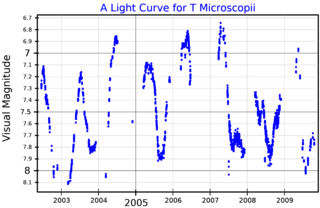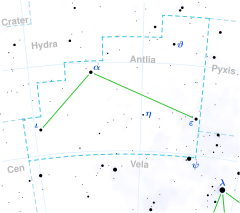Lambda1 Tucanae is the Bayer designation for one member of a pair of stars sharing a common proper motion through space, which lie within the southern constellation of Tucana. As of 2013, the pair had an angular separation of 20.0 arc seconds along a position angle of 82°. Together, they are barely visible to the naked eye with a combined apparent visual magnitude of 6.21. Based upon an annual parallax shift for both stars of approximately 16.5 mas as seen from Earth, this system is located roughly 198 light years from the Sun.
41 Aquarii is a double star in the equatorial constellation of Aquarius. 41 Aquarii is its Flamsteed designation. It is visible to the naked eye as a dim, orange-hued point of light with a combined apparent visual magnitude of 5.354. The pair are located at a distance of around 239 light-years from the Sun based on parallax, but are drifting closer with a radial velocity of –25 km/s.

9 Aurigae is a star system in Auriga (constellation). It has an apparent magnitude of about 5, making it visible to the naked eye in many suburban skies. Parallax estimates made by the Hipparcos spacecraft put it at about 86 light-years from the solar system, although individual Gaia Data Release 3 parallaxes place all three components at 88 light years.

V337 Carinae is a K-type bright giant star in the constellation of Carina. It is an irregular variable and has an apparent visual magnitude which varies between 3.36 and 3.44.

R Centauri is a Mira variable star in the constellation Centaurus.

Theta Persei is a star system 37 light years away from Earth, in the constellation Perseus. It is one of the closest naked-eye stars.
Gliese 412 is a pair of stars that share a common proper motion through space and are thought to form a binary star system. The pair have an angular separation of 31.4″ at a position angle of 126.1°. They are located 15.8 light-years distant from the Sun in the constellation Ursa Major. Both components are relatively dim red dwarf stars.
HD 221776 is a double star in the northern constellation of Andromeda. With an apparent visual magnitude of 6.18, it is viewable by the naked eye user very favourable conditions. The most luminous component has a spectral classification K5III, meaning that it is an orange giant star that has evolved off the main sequence. An infrared excess has been detected around this star, indicating the star is associated with a cloud of dust particles.

HD 33463 is a suspected variable star in the northern constellation of Auriga, about 1,050 light years away. It is a red giant star with a stellar classification of M2III, and has expanded away from the main sequence after exhausting its core hydrogen. It has reached 133 times the size of the Sun and, at an effective temperature of 3,753 K it shines at a bolometric luminosity of 2,114 L☉.

Kappa Herculis is an optical double star in the constellation of Hercules. The two components, Kappa Herculis A and B, were 27.3 arc seconds apart in 2000. Based on parallax measurements from the Hipparcos mission, κ Her A is about 113 parsecs from the Sun and κ Her B is 600 parsecs ; more recent parallax measurements suggest that B is around 5% more distant than A.
ADS 48 is a multiple star system in the constellation of Andromeda consisting of 7 stars. The components, in order from A to G, have apparent visual magnitudes of 8.826, 8.995, 13.30, 12.53, 11.68, 9.949, and 13.00.

V602 Carinae is a red supergiant and variable star of spectral type M3 in the constellation Carina. It is considered to be one of largest known stars, being around 1,000 times larger than the Sun.
29 Camelopardalis is a double star in the circumpolar constellation Camelopardalis. With an apparent magnitude of 6.59, it's right below the max visibility to the naked eye, and can only be viewed under phenomenal conditions. The star is located 484 light years away based on parallax, but is drifting further away with a radial velocity of 3.9 km/s.
145 G. Canis Majoris is a single K giant or supergiant star in the southern constellation of Canis Major. This star is Gould's 145th of Canis Major in his Uranometria Argentina. Kostjuk erroneously lists it as simply "145 CMa". SIMBAD follows this error in its object query result as "* 145 CMa – Star".
HD 102350 is a single star in the constellation Centaurus. It has a yellow hue and is visible to the naked eye with an apparent visual magnitude of 4.11. The distance to this star is approximately 390 light years based on parallax, but it is drifting closer with a radial velocity of −3 km/s. It has an absolute magnitude of −1.51.
Eta Microscopii, Latinised as η Microscopii, is a solitary star in the constellation Microscopium. It is visible to the naked eye as a dim, orange-hued star with an apparent visual magnitude of 5.53. The star is located around 910 light-years distant from the Sun based on parallax, and is drifting further away with a radial velocity of +22 km/s.

T Microscopii is a semiregular variable star in the constellation Microscopium. It ranges from magnitude 6.74 to 8.11 over a period of 352 days. Located around 700 light-years distant, it shines with a bolometric luminosity 7,509 times that of the Sun and has a surface temperature of 2,750 K.

BO Carinae, also known as HD 93420, is an irregular variable star in the constellation Carina.

FU Tauri is a brown dwarf binary system in the constellation of Taurus about 429 light years away. The secondary is very close to the lower limit for brown dwarfs and several databases list it as a distant massive exoplanet.

HD 199223 is a double star in the equatorial constellation Delphinus. However, the system was originally in Equuleus prior to the creation of official IAU constellation borders. The components have a separation of 2″ at a position angle of 282° as of 2016. They have apparent magnitudes of 6.34 and 7.49 and distances of 354 and 359 light years respectively. The system is drifting closer with a radial velocity of −33 km/s.










